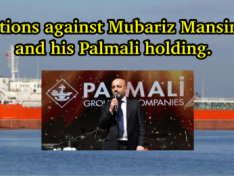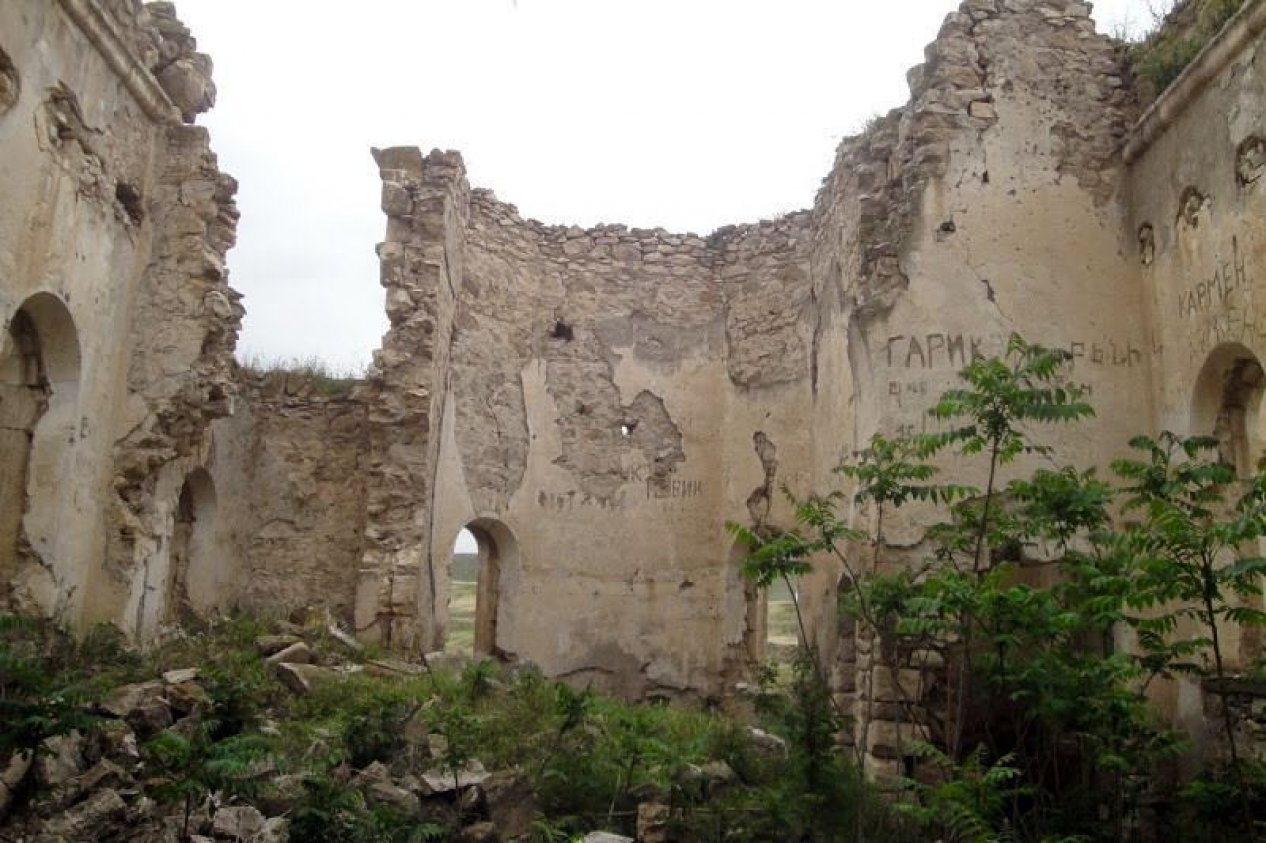
The "Russian community of Nagorno-Karabakh" has acquired a new chairman, Alexander Bordov. The congratulation sent on this occasion says that Armenians and Russians "have always been together both in work and in battle. Together they defended the independence of "Artsakh", the desire of its people to build a bright future."
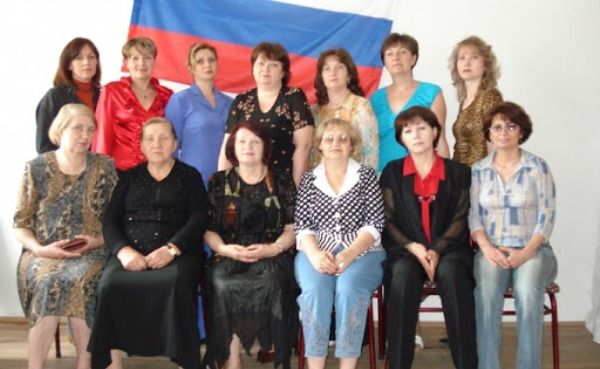
The "Russian community of Nagorno-Karabakh" under the leadership of Alexander Bordov promises to make "a worthy contribution to this cause."
Earlier, Bordov, being deputy chairman, stated that "the Slavic world in Nagorno-Karabakh is a vivid example of the unity of fraternal Orthodox peoples."
Not so long ago, a meeting of the council of the "Russian community of Nagorno-Karabakh" took place in Khankendi. It was reported that "representatives of the largest national minority, who shared all the hardships of the war with the Karabakh Armenians, are beginning to live an active life again, making their contribution to overcoming the consequences of external aggression, helping to build an independent statehood."
As part of this activity, on October 12, the chairperson of the organization, Galina Somova, addressed Russian President Vladimir Putin on behalf of her compatriots. "Dear Vladimir Vladimirovich, do not let Azerbaijan and Turkey do their dirty deed - to complete the genocide, to exterminate us, Christians of Karabakh."
It was reported that the Russian community of Karabakh numbers about 1,500 people. "Some of them are now temporarily outside the republic. Dozens of ethnic Russians and Russian citizens have become refugees. They miraculously escaped, having managed to leave the cities and villages that came under the control of Azerbaijan as a result of the war."
Where did the figure of 1,500 Russians come from in Karabakh?
According to the so-called "population census" in occupied Nagorno-Karabakh, carried out in 2015, 238 persons of Russian nationality and 26 Ukrainians lived in this territory. According to the last Soviet census (1989), there were 2,500 representatives of Slavic nationalities.
That is, the Slavic population of Karabakh was catastrophically reduced as a result of not the second, but the first Karabakh war, and the Russians there fled when their settlements passed under the control of not Azerbaijanis, but Armenians.
Despite the expulsion of the Russian population from Karabakh, the Armenian side throughout the years of the occupation tried to use the "Russian factor" against the peace processes in the South Caucasus.
There is no mention of the “Russian community” in the absolute majority of propaganda materials about the justification of the occupation of Azerbaijani territories by the Armenian troops. The ideologists of Armenian nationalism say nothing about the Russians in Karabakh, only about the Armenians. The project "Russian Community of Karabakh" itself appears in the information field only once every few years in single publications. Even supporters of the occupation of Karabakh in Russia, looking for any way to explain the criminal behavior of Yerevan on Azerbaijani soil, seem to know nothing about such a "community".
Apparently, this is an unsuccessful project of one of the Armenian nationalists, which he or she from time to time tries to revive without much success. Nevertheless, the manifestation of such activity right now and precisely in the context of calls for the protection of the Orthodox heritage in the zone of responsibility of the Russian peacekeepers attract attention.
Another provocation using the "Russian factor" is the proclamation of the Russian language as the second official language on the territory controlled by the peacekeepers. Considering that this issue has not been raised for 30 years, and there are practically no Russians in the region, the decision of the Karabakh Armenians does not reflect the real situation, but pursues far-reaching geopolitical goals.
In fact, the Russian community of Nagorno-Karabakh was forcibly expelled by the Armenian side during the occupation, says Anastasia Lavrina, deputy chairman of the Russian community of Azerbaijan, commenting on the destruction of Orthodox churches in Karabakh by Armenia.
The occupation of Nagorno-Karabakh by Armenia left not only Azerbaijanis without shelter, but representatives of other peoples living in Azerbaijan. Among those who were left homeless in places of historical residence were Molokans from a small village in Karabakh, who for more than 150 years lived in peace and harmony with their Azerbaijani neighbors. In 1993, the Russian Old Believers, having lost everything, were expelled by the Armenians from their homes. They never hid the fact that at the first opportunity they would return home, restore their state farm, their vineyards. Elena Timofeeva is one of the residents of the Karabakh village who remained to live in Azerbaijan. In an interview with "Moscow-Baku" she told about her dream to see her native lands again.
The village is called Goyarkh, it belongs to the Terter region of Azerbaijan. Even in the Soviet years, the Armenians terrorized the Russian village. "They shared the Tartar River with us. Even then they were enemies with us, and didn’t let us on their side." People started to leave the village even before the conflict began, when there was only talk of an imminent war. The Azerbaijani army saved 52 Molokans from the Armenian massacre in 1993. Today, after the victory of Azerbaijan, the inhabitants of Goyarkh want to return to their village. These are 27 families from Russia who want to return again to Azerbaijan, to the village in Karabakh, in the hope that there will be no more war and no one will expel them from their native land, she said.
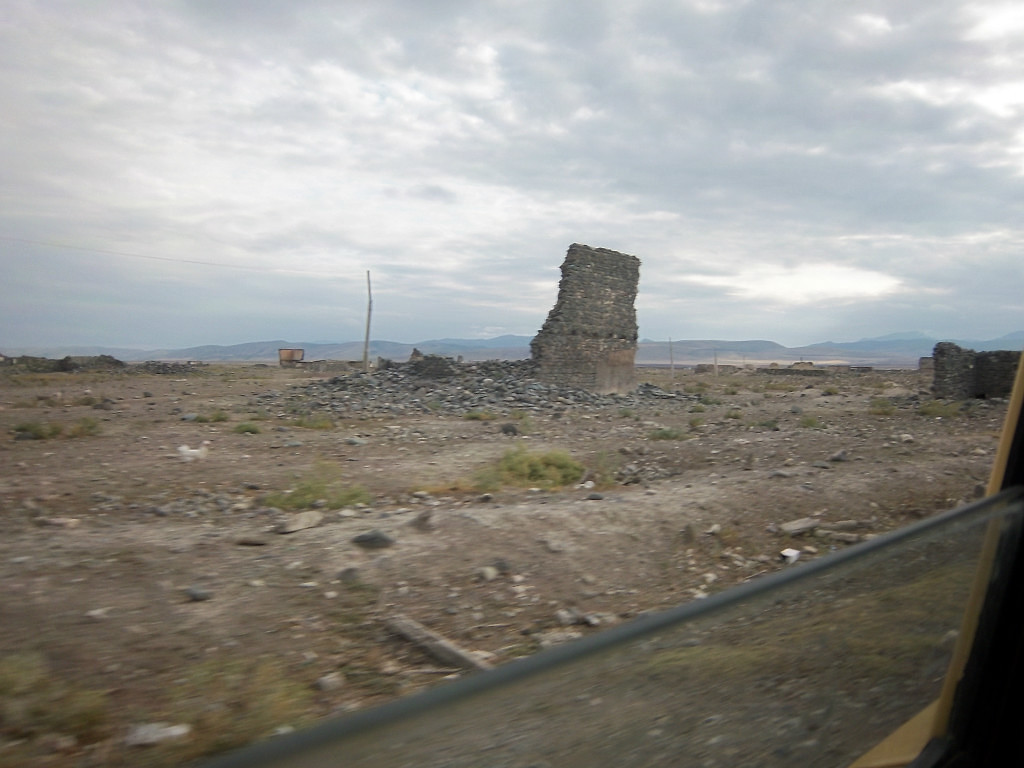
Despite the statements of the Armenians and the so-called "Russian community of Nagorno-Karabakh" about the alleged persecution and ethnic cleansing of the Russian population by the Azerbaijanis, the Russians themselves in Azerbaijan know the truth. The Azerbaijani parliament receives appeals from Russian families who want to return to the liberated lands of Karabakh, said the head of the Russian community of Azerbaijan, MP Mikhail Zabelin. He said that four Russian families had already approached him, who wish to return to their homes in the territories liberated from the Armenian occupation in Karabakh. Two Molokan families now living in the Krasnodar Krai and two families from the village of Russkiye Borisy (Goranboy region of Azerbaijan) expressed their desire to return to the Terter region, where they previously lived, but were subsequently expelled by the Armenian armed formations. Zabelin noted with regret that their village was completely destroyed during the occupation.
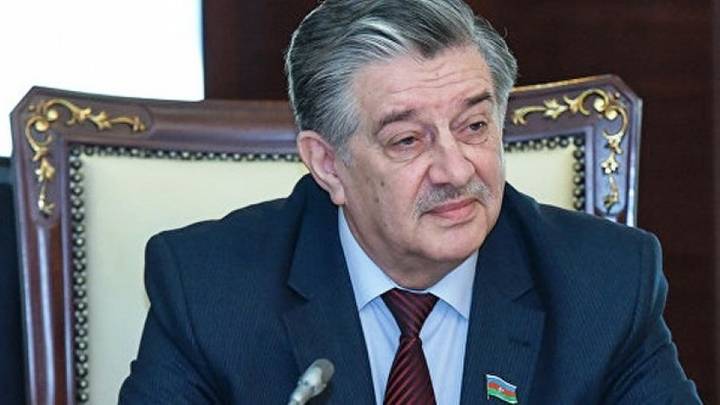
The Armenian side asserts that "Russians living in Karabakh have no problems in preserving their national culture, traditions, and language." But the state of the Orthodox churches that remained in the occupied territories speaks of the attitude of Armenians towards the Russian spiritual heritage during the period of occupation.
As the late Bishop of the Russian Orthodox Church, Archbishop of Baku and Azerbaijan Alexander (Ishchein) noted, “unfortunately, there is information about the poor condition of Orthodox churches in the liberated territories. The external and internal appearance of the Orthodox Church of John the Baptist in Shusha has been changed. The domes from the bell towers and those from the temple were removed, replaced with the attributes of the Armenian-Gregorian church. The Church of the Transfiguration of the Lord in Khojavend is in a terrible state, although in Soviet times it was a beautiful temple. Now there are only four walls left overgrown with weeds and trees."
The Russian Church in Khojavend, built in 1894, is of value not only as a place of religious worship, but also as an architectural monument. But in the early 1990s, it ended up in the territory occupied by Armenia and fell into decay over 30 years.
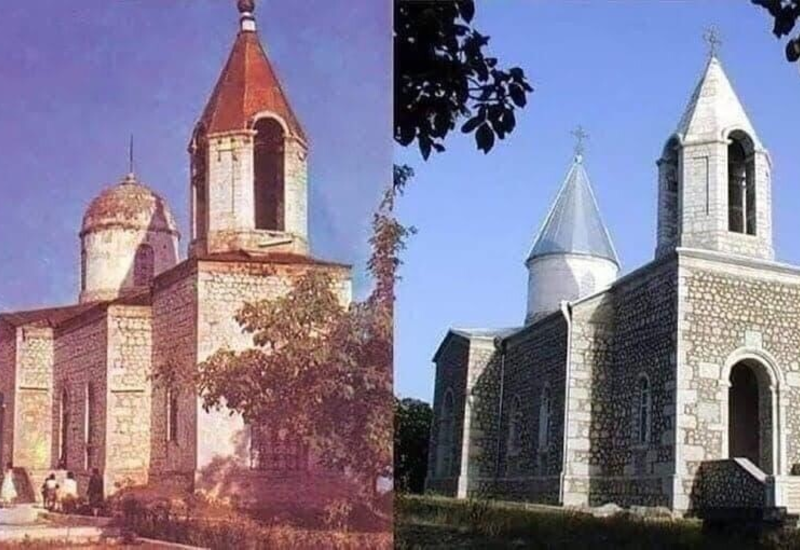
The Russian church in Shusha was built even earlier, in 1847. After the occupation of Nagorno-Karabakh in 1992, the Armenians destroyed its dome, erecting their own and renaming it "Khanach Zham". This happened, of course, without the notification and permission of the local diocese of the Russian Orthodox Church.
Armenian vandalism extends not only to the historical, cultural and religious heritage of ethnic Azerbaijanis in the Caucasus, but even to the religious shrines of co-religionists and political allies. As an example, it is safe to show the Russian Orthodox Church in honor of the Transfiguration of the Lord in Gevorgavan (Kuropatkino).
This is the only temple of the Russian Orthodox Church on the territory of Nagorno-Karabakh. It is located on the territory of the Khojavend region, which was occupied in February 1992 by the Armenian Armed Forces.
A military facility of the Armed Forces was located in the immediate vicinity of the church. Speaking about the Armenian vandalism, the publication, for the sake of objectivity, refers to the posts of the Armenian blogger Vahe Martirosyan.
Martirosyan showed photos of the Church of the Transfiguration of the Lord in Gevorgavan from 1988 and 2000. The photos show that the church was in good condition at that time. There was a roof and bars on the windows. Considering that the occupation of the Khojavend region took place in 1992, and the state of the church in 1988 and 2000 does not differ, it can be concluded that the church did not suffer during the first Karabakh war, that is, it did not become a victim of the fighting. In 2014, Vahe Martirosyan visited this church and showed photos of its condition at that time. The roof and the front were destroyed. The iron bars have been removed from the windows; there are severe damages on the façade from the west. Armenian vandals left their autographs - Armen, Garik, Karmen, etc.
The publication notes that the church was not on the frontline and the fire damage to the facade from the side where the Armenian Armed Forces were located is not accidental. Considering the fact that the church was located in close proximity to the military facility of the Armenian Armed Forces, the military-political leadership of Armenia was well aware of everything that was happening.
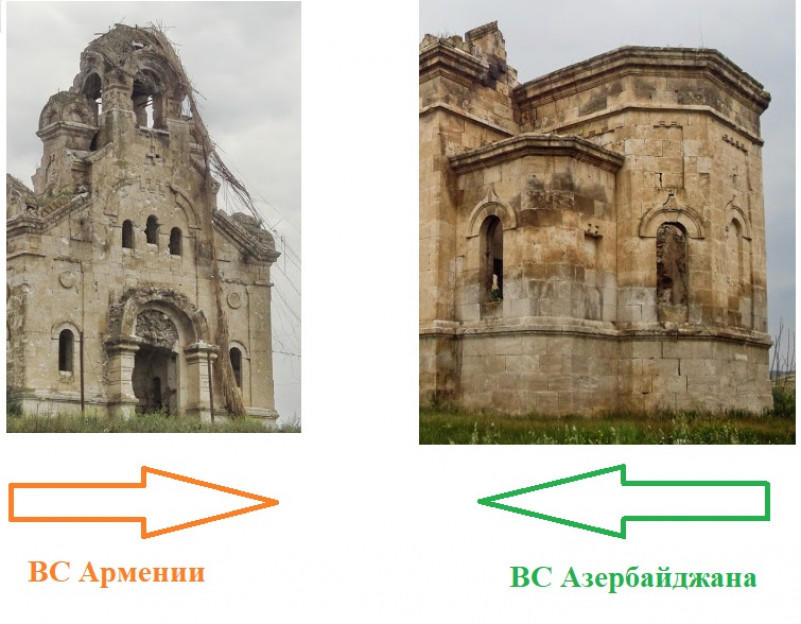
In 2009 in Khankendi, a solemn laying of the first stone took place in the foundation of the Orthodox Church of the Intercession of the Holy Mother of God and the erection of the cross. In November 2009, the "Russian community of Nagorno-Karabakh" received a territory of 6,110 square meters for free use. meters. A delegation from Russia arrived in Nagorno-Karabakh to participate in the ceremony of starting the erection of the temple. The rite of foundation of the church was conducted by the priest of the Russian Orthodox Church, Alexander, who expressed gratitude to the "authorities" of the region for the decision to build a church for the "Russian community".
12 years have passed, but things have not gone further than laying the “first stone.”

Finally, the very name of the community - "Russian community of Nagorno-Karabakh" is inappropriate. President of Azerbaijan Ilham Aliyev has stated that there is no territorial unit called Nagorno-Karabakh on the territory of Azerbaijan. This word, expression should not be used at all. There is no Nagorno-Karabakh, there is Karabakh, the head of state stressed.
Thus, we have proved that the organization called "Russian Community of Nagorno-Karabakh" is a fake structure used by the Armenian side for propaganda purposes. In fact, the Russian population also suffered from the Armenian occupation, and the spiritual heritage of the Russian people was destroyed by the invaders. We also found that the Armenian side is trying to inflate the number of Russians in Karabakh, while even in Wikipedia, which is moderated by the Armenians, completely different figures are indicated.


